-
- DRINKING
IN NEW ZEALAND
- National
Surveys Comparison 1995
& 2000
-
- Ruth
Habgood, Sally Casswell, Megan Pledger and Krishna Bhatta,
-
- Alcohol
& Public Health Research Unit, November 2001
This
section examines how often drinkers consumed alcohol, the quantity they
typically drank on each occasion and the frequency with which they drank larger
quantities or enough to feel drunk.
FREQUENCY
OF DRINKING
- The
average frequency of drinking for those who drank alcohol in the previous 12
months increased between 1995 and 2000 from 162 to 168 occasions per year or
to about once every 2-3 days. The increases were mainly among the younger
drinkers and those aged 50-65. The average 14-15 year old became a weekly
drinker (increasing from 42 to 64 occasions per year) and those aged 16-17
increased from 76 to 110 occasions per year between 1995 and 2000.
- Although
the average frequency of drinking for men remained at the same level between
1995 and 2000 (203 occasions per year), there was an increase in how often
women drank, (from 126 to 136 occasions per year).
- Among
men, those aged 20-24 drank most often (Figure 8) and this was the case in
both 1995 and 2000. There were no significant changes in drinking frequency
for this group between 1995 and 2000. The 14-15 year olds, while remaining
relatively infrequent drinkers, did increase how often they drank, from 44
occasions per year in 1995 to 62 in 2000.
Figure 8
-
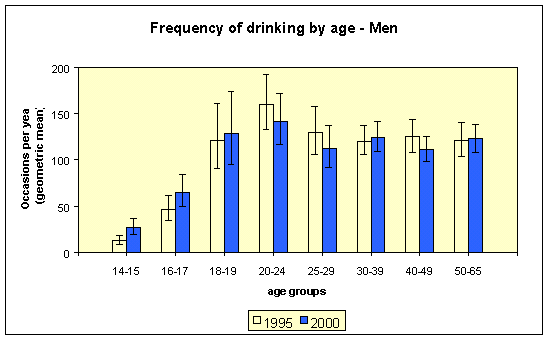
- Women
increased how often they drank between 1995 and 2000 across all the age
groups but they still drank less often than men. There were increases among
14-15 and 16-17 year old women (39 to 67 and 67 to 92 occasions per year
respectively) and among those aged 30-49.
Figure
9
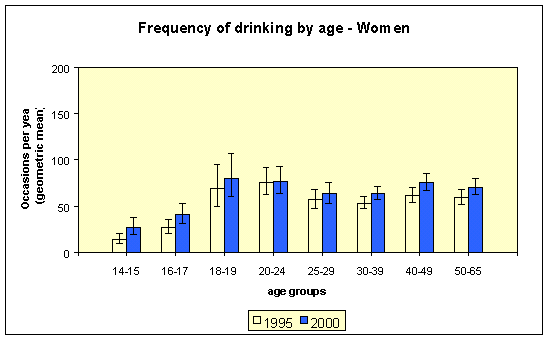
- Fifteen
percent of drinkers were drinking every day in 2000. Almost 20% of men
drinkers and approximately 10% of women drinkers consumed alcohol at least
once a day and there was no change in these proportions between 1995 and
2000.
- Among
the drinkers, the prevalence of daily drinking was greatest among 50 to 65
year olds (almost 30% of men and more than 15% of women in this age group
were drinking at least daily). One fifth of 18-19 year old men and over one
quarter of men aged 20-25 were drinking at least daily. Less than one eighth
of women in these age groups were drinking as often.
- At
the other extreme, 12% of drinkers were drinking less than once a month in
1995 but this proportion had decreased to 10% by 2000. This was largely due
to the percentage of women who consumed alcohol less than once a month,
which decreased from 17% to 12%. There was a marked decrease among 14-15
year olds who consumed alcohol less than once a month, and particularly
among 14-15 year old women (from 42% in 1995 to 24% in 2000).
- Combined
with the abstainers, this means 27% of the women in the sample consumed
alcohol rarely or never and this was a significant decrease from 1995 (30%).
Nineteen percent of men were abstainers in 2000 and this had not changed
since 1995. There was a sharp drop in the proportions of 14-15 year olds
(from 66% to 51%) who drank rarely or never between 1995 and 2000. This
decrease was particularly marked among 14-15 and 18-19 year old women
(decreasing from 68% to 49% and from 33% to 20% respectively).
- There
were differences between the Central region with the highest frequency, 175
occasions per year, and the Midlands with the lowest, 152 occasions per
year. There were also some differences between regions in terms of the
changes that had occurred between 1995 and 2000. Those living in the Central
and Southern regions drank more often than they had in 1995 and this was
particularly marked among women. Men living in the Northern region were the
only group to drink less often in 2000 than in 1995.
- There
were increases in frequency of drinking of those living in small cities and
small towns. Men in metropolitan areas slightly decreased how often they
drank between 1995 and 2000 but drinking frequency increased for women in
small cities and large and small towns.
TYPICAL
OCCASION QUANTITY
- The
typical quantity of alcohol consumed on a drinking occasion averaged across
all drinkers, rose between 1995 and 2000, from 51mls to 61mls of absolute
alcohol. This increase, across all the drinkers, amounted to less than one
drink. This increase was across all age groups. The largest increases were
reported among the younger age groups, from three to five drinks for 14-15
year olds, from 4 to 7 drinks for 16-17 year olds and from 5 to 7 drinks for
18-19 year olds.
- For
men who were drinkers, the average quantity consumed on a typical occasion
increased between the surveys, from 65mls or just over four cans of beer in
1995, to 72mls or just under five cans in 2000. For women there was a larger
increase, from 39mls or just over two glasses of wine in 1995, to 52mls or
between three and four glasses per occasion in 2000.
- Among
men, there were marked increases in the typical quantities consumed by the
youngest males, those aged 14-15 and 16-17, and increases in all of the age
groups 30 years and over.
- The
average amount consumed by males aged 14-15 on a typical occasion increased
from 47mls or three drinks in 1995 to 75mls or five drinks in 2000. For
16-17 year old males the quantities rose from about 74mls or five drinks per
occasion in 1995 to 122mls or eight drinks in 2000. These amounts were only
exceeded by the 18-19 year olds who were the heaviest drinkers in 2000.
- Increases
in the average amounts consumed by 18-19 year old males, from 97mls to
125mls, did not reach the level of significance. Nevertheless, the typical
amounts consumed by both the 16-17 and 18-19 year old age groups in 2000
exceeded that of the heaviest drinkers in 1995, the 20-24-year olds who were
consuming an average of seven drinks per occasion.
Figure
10
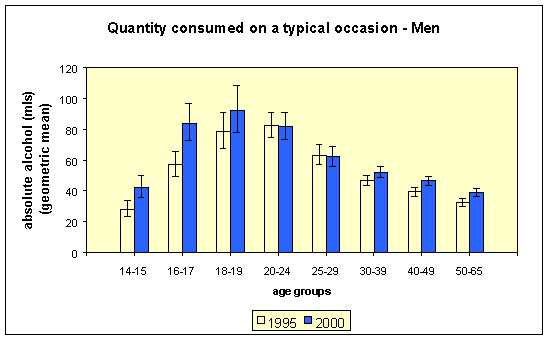
- Women
showed increases in the typical quantities consumed across all age groups.
The increases were most marked among those aged 16-17, 18-19 and 20-24 years
(from 4 to 6 drinks), although there were significant increases in all age
groups over 16 years. In 2000 the largest quantities were consumed by 18-19
year old women the equivalent of over six glasses of wine (95mls), an
increase of almost two and a half drinks per occasion. For 16-17 and 20-24
year olds it was just under six glasses (84mls) an increase of just under
two drinks per occasion for each age group.
Figure
11
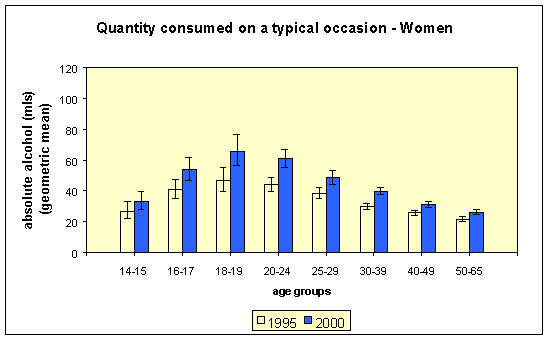
- To
further explore this picture of increased typical drinking quantities, the
drinkers were divided into those reporting different numbers of drinks in
typical drinking occasions. Twenty-seven percent of men who were drinkers in
1995 typically drank less than two drinks. By 2000, this percentage had
decreased to 23%. For men aged 16-17 it had decreased from 21% to 14%.
- Fourteen
percent of the male drinkers typically consumed eight or more drinks and
there was no change in this level from 1995 to 2000. There were increases in
the percentage of men aged 16-17 and 40-49 who were drinking larger
quantities (eight or more drinks). In 1995, 19% of males aged 16-17 drank
eight or more drinks on typical drinking occasions and this had increased to
36% in 2000.
- The
picture of fewer people drinking smaller quantities was repeated for women
but more women than men were also drinking larger quantities. The percentage
of women drinking two drinks or fewer decreased from 47% to 35%. There were
decreases in the proportion of women drinking smaller amounts irrespective
of age group, but particularly among those aged 18-19 and 25-39.
- Seven
percent of women typically drank six drinks or more in 1995, but this had
increased to 11% by 2000. Marked increases in the proportions of women
drinking six or more drinks per occasion were found among 18-19 year olds
(17% to 33%) and increases were also found among 25-29 year olds (11% to
20%) and 30-39 year olds (5% to 11%).
- In
the 2000 survey there were no differences between the four regions of the
country, or in different levels of urbanisation, in the typical quantities
being consumed. The increases found from 1995 to 2000 occurred in all
regions and every level of urbanisation except large towns. Increases were
also found for women in all regions and levels of urbanisation, except large
towns. Increases for men were strongest for those residing in the Midlands
and Northern regions and in metropolitan and rural areas.
FREQUENCY
OF DRINKING LARGER AMOUNTS
- Drinkers
were asked how often they consumed larger amounts in one session. For men
this larger amount was set at six drinks with a drink equivalent to 15 mls
or a can of beer, glass of wine or double nip of spirits. For women the
larger amount was set at four drinks.[1]
-
- Fourteen
percent of drinkers stated that they drank these larger amounts at least
once a week in both 1995 and 2000. There was no change in the percentage of
women drinking these amounts at least once a week but there was a decrease
in the proportion of men who did so (from 21% to 19%).
-
- In
the 2000 survey men and women in the 18-19 year old age group were the most
likely to consume these larger amounts, with just under 40% of men and just
under 30% of women doing so at least weekly (Figure 12 and13).
-
- There
were no changes in any age groups between 1995 and 2000 for men.
Figure
12
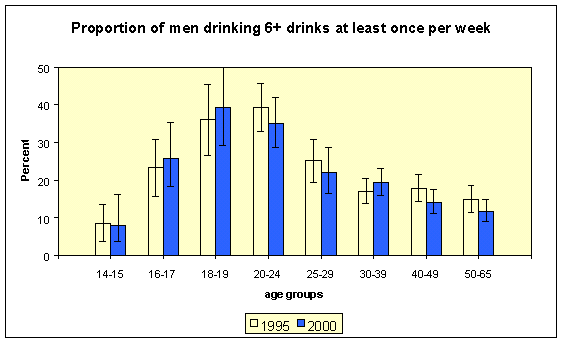
- Women
were asked how often they consumed four or more 15ml drinks. Just less than
10% of women drinkers (8% in 1995 and 9% in 2000) said they did so at least
weekly. While there was little change among women overall in the proportions
drinking larger amounts at least weekly, there were marked increases among
the 16-17 year olds, where the proportions more than doubled between 1995
and 2000 (from 10% to 21%).
Figure
13
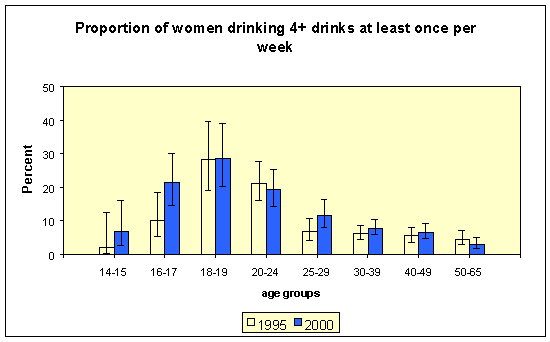
FREQUENCY
OF DRINKING ENOUGH TO FEEL DRUNK
- Nine
percent of drinkers reported drinking enough to feel drunk at least once a
week in 2000 and these proportions did not change between 1995 and 2000.
However, there was an increase from 10% to 17% in the numbers of 16-17 year
olds who did so.
- While
around 13% of all men consumed enough alcohol to feel drunk at least once a
week, more than one third of men aged 18-19 did so. Similarly among women,
while 6% consumed enough to feel drunk at least once a week, 23% of women
aged 18–19 did so.
- There
were marked increases in the proportion of 16-17 year olds who drank enough
to feel drunk at least once a year. Eighty-four percent of 16-17 year old
males had done so – an increase from 71% in 1995.
Figure 14

There
was an increase between 1995 and 2000 in the proportion of women who were
drinking enough to feel drunk at least once a week (4% to 6%).
- Fifty
percent of women drank enough to feel drunk at least once a year and this
had increased from 44% in 1995. There was a large increase in the proportion
of women aged 16-17 who had done so, from 68% in 1995 to 82% in 2000. There
were also increases among women aged 30-39, from 48% to 55% and among those
aged 50-65, from 10% to 19%.
Figure 15
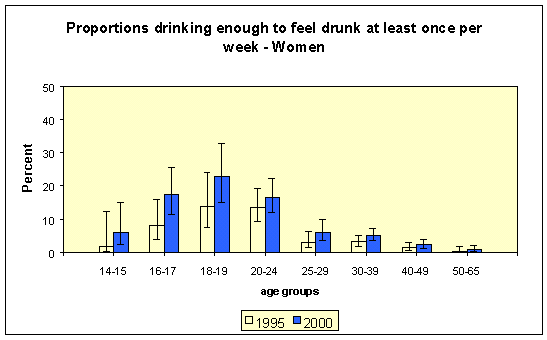
Top | Back |
Next
| Home







